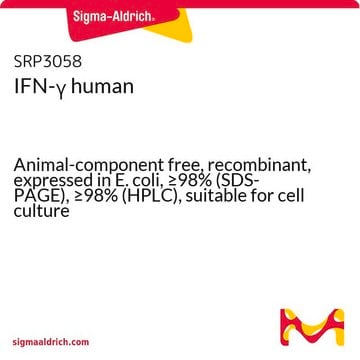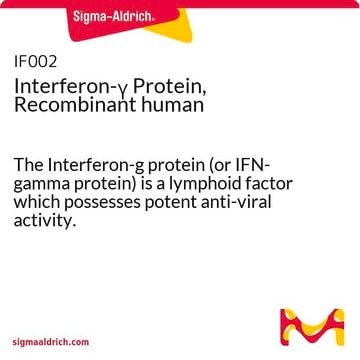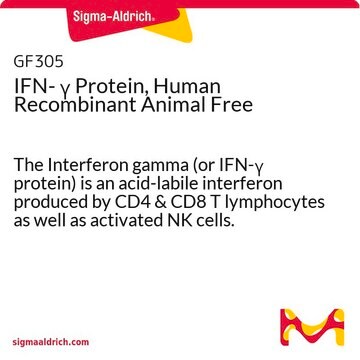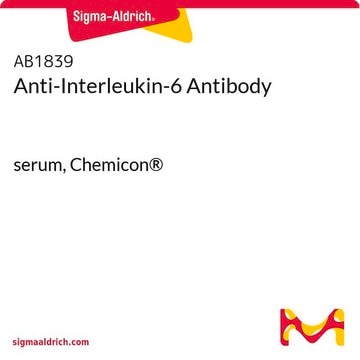GF314
TNF- α Protein, Human Recombinant Animal Free
Tumor necrosis factor alpha (TNF-α), also known as cachectin & TNFSF1A, is the prototypic ligand of the TNF superfamily. Recombinant animal free human TNF-α is manufactured using all non-animal reagents.
Synonym(s):
Tumor Necrosis Factor Alpha, TNFa, TNF-alpha, Cachectin, TNFSF1A
Sign Into View Organizational & Contract Pricing
All Photos(1)
About This Item
UNSPSC Code:
12352202
eCl@ss:
32160405
NACRES:
NA.77
Recommended Products
recombinant
expressed in E. coli
Quality Level
assay
>98% (SDS-PAGE and HPLC)
impurities
<0.1 μg/mg protein endotoxin (<1EU/μg)
NCBI accession no.
UniProt accession no.
shipped in
dry ice
Related Categories
General description
Product Source: E. coli
Tumor necrosis factor alpha (TNF-α), also known as cachectin and TNFSF1A, is the prototypic ligand of the TNF superfamily. It is a pleiotropic molecule that plays a central role in inflammation, apoptosis, and immune system development. TNF-α is produced by a wide variety of immune and epithelial cell types. It belongs to the TNF family of ligands and signals through two receptors, TNFR1 and TNFR2. TNF-α is cytotoxic to a wide variety of tumor cells and is an essential factor in mediating the immune response against bacterial infections. TNF-α also plays a role in the induction of septic shock, auto immune diseases, rheumatoid arthritis, inflammation, and diabetes. Recombinant human TNF-α is a soluble 157 amino acid protein (17.4 kDa) which corresponds to C-terminal extracellular domain of the full length transmembrane protein.
Specificity
Cross Reactivty
Cow, Monkey, Mouse, Rat, Sheep
Cow, Monkey, Mouse, Rat, Sheep
Application
Research Category
Inflammation & Immunology
Inflammation & Immunology
Research Sub Category
Growth Factors & Receptors
Growth Factors & Receptors
Quality
Bioactivity assay: The ED50 as determined by the cytolysis of murine L929 cells in the presence of Actinomyocin D is ≤ 0.05 ng/ml, corresponding to a specific activity of ≥2 x 107 units/mg.
Physical form
Product is filtered through a 0.2 micron filter before lyophilization.
Recombinant animal free human TNF- α is manufactured using all non-animal reagents
Storage and Stability
Store at -20°C for up to 6 months from date of receipt.
Disclaimer
Unless otherwise stated in our catalog or other company documentation accompanying the product(s), our products are intended for research use only and are not to be used for any other purpose, which includes but is not limited to, unauthorized commercial uses, in vitro diagnostic uses, ex vivo or in vivo therapeutic uses or any type of consumption or application to humans or animals.
Storage Class
11 - Combustible Solids
wgk_germany
WGK 3
Certificates of Analysis (COA)
Search for Certificates of Analysis (COA) by entering the products Lot/Batch Number. Lot and Batch Numbers can be found on a product’s label following the words ‘Lot’ or ‘Batch’.
Already Own This Product?
Find documentation for the products that you have recently purchased in the Document Library.
Customers Also Viewed
Bjarne Østerud et al.
Journal of thrombosis and haemostasis : JTH, 20(4), 866-876 (2021-11-26)
Most tissue factor (TF) activity assays are based on measurement of factor X (FX) activation by TF in the presence of factor VII (FVII)/FVIIa. This requires long incubation, which may result in TF-independent activity of FX and inaccurate measurement of
Toll-like receptor 9 (TLR9) gene deletion-mediated fracture healing in type II diabetic osteoporosis associates with inhibition of the nuclear factor-kappa B (NF-I?B) signaling pathway.
Han, et al.
Bioengineered, 13, 13689-13702 (2022)
Ruo-Yu Chen et al.
Cell death & disease, 12(11), 983-983 (2021-10-24)
Chronic and persistent inflammation is a well-known carcinogenesis promoter. Hepatocellular carcinoma (HCC) is one of the most common inflammation-associated cancers; most HCCs arise in the setting of chronic inflammation and hepatic injury. Both NF-κB and STAT3 are important regulators of
Zhihua Ye et al.
Cell death & disease, 13(7), 633-633 (2022-07-22)
Uncontrolled growth, distant metastasis and chemoresistance are critical characteristics of pancreatic ductal adenocarcinoma (PDAC), and they result in high mortality; however, the mechanisms triggering these effects have not been fully investigated. In this study, we analysed a dataset in the
Ruo-Yu Chen et al.
Cell death and differentiation, 27(4), 1259-1273 (2019-09-13)
Centrosomal P4.1-associated protein (CPAP) is overexpressed in hepatocellular carcinoma (HCC) and positively correlated with recurrence and vascular invasion. Here, we found that CPAP plays an important role in HCC malignancies. Functional characterization indicated that CPAP overexpression increases tumor growth, angiogenesis
Our team of scientists has experience in all areas of research including Life Science, Material Science, Chemical Synthesis, Chromatography, Analytical and many others.
Contact Technical Service








